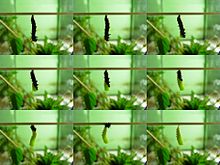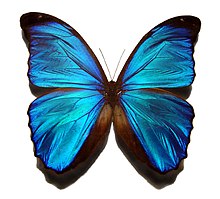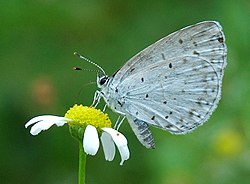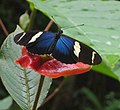| Revision as of 15:41, 28 March 2006 view sourceCotinis (talk | contribs)Extended confirmed users1,522 edits →Images: add link to BugGuide.net--many images of North American Butterflies, many CC licensed← Previous edit | Revision as of 19:51, 28 March 2006 view source BerneyBoy (talk | contribs)14 edits →External links - Schematic of a ButterflyNext edit → | ||
| Line 171: | Line 171: | ||
| * | * | ||
| * | * | ||
| * | |||
| ===Regional=== | ===Regional=== | ||
Revision as of 19:51, 28 March 2006
For other uses, see Butterfly (disambiguation).
| Butterflies | |
|---|---|
| File:Flutterbye.jpg | |
| A Viceroy, mimic of the Monarch | |
| Scientific classification | |
| Kingdom: | Animalia |
| Division: | Rhopalocera |
| Phylum: | Arthropoda |
| Class: | Insecta |
| Order: | Lepidoptera |
| Families | |
| |
A butterfly is a flying insect of the order Lepidoptera, and belongs to one of the superfamilies Hesperioidea (the skippers) or Papilionoidea (all other butterflies). Some authors would include also members of the superfamily Hedyloidea, the American butterfly moths. Many butterflies have striking colours and patterns on their wings. When touched by humans, they tend to lose some scales, that look like a fine powder. If they lose too many scales, their ability to fly will be impaired. People who study or collect butterflies (or the closely related moths) are called lepidopterists. Butterfly watching is growing in popularity as a hobby.
Several species of butterflies need more sodium than provided by the nectar they drink from flowers. As such, they are attracted to the sodium in salt (which the males often give to the females to ensure fertility). As human sweat contains significant quantities of salt, they sometimes land on people, to the delight of the young at heart everywhere.
The scales on the butterfly wings have many properties, mostly optical, that interest scientists. The pattern they make are also seen as the best animal system for understanding the developmental and genetic processes that produce morphological variation in nature.
The four stages in the lifecycle of a butterfly

Unlike many insects, butterflies do not experience a nymph period, but instead go through a pupal stage which lies between the larva and the adult stage (the imago).
Egg
Butterfly eggs consist of a hard-ridged outer layer of shell, called the chorion. This is lined with a thin coating of wax which prevents the egg from drying out before the larva has had time to fully develop. Each egg contains a number of tiny funnel-shaped openings at one end, called micropyles; the purpose of these holes is to allow sperm to enter and fertilize the egg. Butterfly and moth eggs vary greatly in size between species, but they are all either spherical or ovate.
Larva
Larvae, or caterpillars, are multi-legged eating machines. They consume plant leaves and spend practically all of their time in search of food. Caterpillars mature through a series of stages, called instars. Near the end of each instar, the larva undergoes a process called apolysis, in which the cuticle, a mixture of chitin and specialized proteins, is released from the epidermis and the epidermis begins to form a new cuticle beneath. At the end of each instar, the larva molts the old cuticle, and the new cuticle rapidly hardens and pigments. Development of butterfly wing patterns begins by the last larval instar. Butterflies belong to the specialized and prolific lineage of holometabolous insects, which means that wings or wing pads are not visible on the outside of the larva, but when larvae are dissected, tiny developing "wing disks" can be found on the second and third thoracic segments, in place of the spiracles that are apparent on abdominal segments. Wing disks develop in association with a trachea that runs along the base of the wing, and are surrounded by a thin "peripodial membrane", which is linked to the outer epidermis of the larva by a tiny duct.

Wing disks are very small until the last larval instar, when they increase dramatically in size, are invaded by branching tracheae from the wing base that precede the formation of the wing veins, and begin to express molecular markers in patterns associated with several landmarks of the wing. Near pupation, the wings are forced outside the epidermis under pressure from the hemolymph, and although they are initially quite flexible and fragile, by the time the pupa breaks free of the larval cuticle they have adhered tightly to the outer cuticle of the pupa (in obtect pupae). Within hours, the wings form a cuticle so hard and well-joined to the body that pupae can be picked up and handled without damage to the wings.
| This template is a customized wrapper for {{]}}. Any field from {{]}} can work so long as it is added to this template first. Questions? Just ask here or over at ]. |
|

|
|}
Pupa
When the larva exceeds a minimum weight at a particular time of day, it will stop feeding and begin "wandering" in a quest for a suitable pupation site, usually the underside of a leaf. The larva transforms into a pupa (chrysalis), which then transforms into a butterfly by metamorphosis. To transform from the miniature wings visible on the outside of the pupa into large structures usable for flight, the pupal wings undergo rapid mitosis and absorb a great deal of nutrients. If one wing is surgically removed early on, the other three will grow to a larger size. In the pupa, the wing forms a structure that becomes compressed from top to bottom and pleated from proximal to distal ends as it grows, so that it can rapidly be unfolded to its full adult size. Several boundaries seen in the adult color pattern are marked by changes in the expression of particular transcription factors in the early pupa.

Butterfly
The adult, sexually mature, stage of the insect is known as the imago. As Lepidoptera, butterflies have four wings that are covered with tiny scales (see photo), but, unlike moths, the fore- and hindwings are not hooked together, permitting a more graceful flight. A butterfly has six legs; the larva also has six true legs and a number of prolegs. After it emerges from its pupal stage, it cannot fly for some time, because its wings have not yet unfolded. A newly-emerged butterfly needs to spend some time 'inflating' its wings with blood and letting them dry, during which time it is extremely vulnerable to predators.

Many species of butterfly are sexually dimorphic. Some butterflies, such as the Monarch butterfly, are migratory.
Butterflies are often confused with moths, but there are a few simple differences between them, including colour, habits, and pupating appearance. See the difference between a butterfly and a moth.
Butterflies live primarily on nectar from flowers. Some also derive nourishment from pollen, tree sap, rotting fruit, dung, and dissolved minerals in wet sand or dirt. Butterflies are also pollinators.
Classification
| This template is a customized wrapper for {{]}}. Any field from {{]}} can work so long as it is added to this template first. Questions? Just ask here or over at ]. |
|

|-
|

|-
|

|} Although the butterflies are classified in two superfamilies, Hesperioidea and Papilionoidea, these are sister taxa, so the butterflies collectively are thought to constitute a true clade. Some modern taxonomists place them all in superfamily Papilionoidea, distinguishing the skippers from the other butterflies at the series level only. There is only one family in the Hesperioidea (or series Hesperiiformes), the skipper family Hesperiidae. The families usually recognised in the Papilionoidea (or Papilioniformes) are:
- Swallowtails and Birdwings, Papilionidae
- Whites or Yellow-Whites, Pieridae
- Blues and Coppers or Gossamer-Winged Butterflies, Lycaenidae
- Metalmark butterflies, Riodinidae
- Brush-footed butterflies, Nymphalidae
A major new study (Wahlberg et al., 2005) combining morphological and molecular data concluded that Hesperiidae, Papilionidae, Pieridae, Lycaenidae and Riodinidae could all be strongly supported as monophyletic clades, but the status of Nymphalidae is equivocal. Lycaenidae and Riodinidae were confirmed as sister taxa, and Papilionidae as the outgroup to the rest of the true butterflies, but the location of Pieridae within the pattern of descent was unclear, with different lines of evidence suggesting different conclusions. The data suggested that the Hedyloidea are indeed more closely related to the butterflies than to other moths.
Some older classifications recognize additional families, for example Danaidae, Heliconiidae, Libytheidae and Satyridae, but modern classifications treat these as subfamilies within the Nymphalidae.
There are between 15,000 and 20,000 species of butterflies worldwide. Some well known species include:
- Small Tortoiseshell, Nymphalis urticae
- Small White, Artogeia rapae
- Green-veined White, Artogeia napi
- Monarch butterfly, Danaus plexippus
- Red Admiral, Vanessa atalanta
- Painted Lady or Cosmopolite, Vanessa cardui
- Peacock, Inachis io
- Xerces Blue, Glaucopsyche xerces
- Gulf Fritillary, Agraulis vanillae
- Black Swallowtail, Papilio polyxenes
- Spicebush Swallowtail, Papilio troilus
- Karner Blue, Lycaeides melissa samuelis (endangered)
- Morpho genus
- Troides genus (birdwings; the largest butterflies)
- Speckled Wood, Pararge aegeria
- Northern Pearly Eye Enodia anthedon
Etymology
A false etymology claims that the word butterfly came from a metathesis of "flutterby"; however, the Old English word was buttorfleoge and a similar word occurs in Dutch, apparently because butterflies were thought to steal milk. An alternative folk etymology, current in Great Britain, is that it originated as a contraction of term butter-coloured fly referring to the Brimstone Buterfly Gonepteryx rhamni, often the first butterfly of Spring.
Aerodynamics, butterflies, and flutter
Unlike many other members of the insect world, the flight of a butterfly can be explained quantitatively (and quite accurately) using steady-state, non-transitory aerodynamics. The aspect ratio of a butterfly's wing is ideal to be described using thin airfoil theory. The fluttering of the wings merely serves to enforce the Kutta condition of low-speed aerodynamics. For a more detailed description, see Insect flight.
Field guides to butterflies

- Butterflies of North America, Jim P. Brock and Kenn Kaufman (2003)
- Butterflies through Binoculars: The East, Jeffrey Glassberg (1999)
- Butterflies through Binoculars: The West, Jeffrey Glassberg (2001)
- A Field Guide to Eastern Butterflies, Paul Opler (1994)
- A Field Guide to Western Butterflies, Paul Opler (1999)
- Peterson First Guide to Butterflies and Moths, Paul Opler (1994)
- The Millennium Atlas of Butterflies in Britain and Ireland by Jim Asher (Editor), et al.
- Pocket Guide to the Butterflies of Great Britain and Ireland by Richard Lewington
- Butterflies of Britain and Europe (Collins Wildlife Trust Guides) by Michael Chinery
- Butterflies of Europe by Tom Tolman and Richard Lewington (])
- Butterflies of Europe New Field Guide and Key by Tristan Lafranchis (2004)
- A Guide to Common Butterflies of Singapore by Steven Neo Say Hian (Singapore Science Centre)
- Butterflies of West Malaysia and Singapore by W.A.Fleming. (Longman Malaysia)
- Las Mariposas de Machu Picchu by Gerardo Lamas (2003)
- The Butterflies of the Malay Peninsula by A.S. Corbet and H. M. Pendlebury. (The Malayan Nature Society)
See also
- List of British butterflies
- List of U.S. state butterflies
- List of butterflies of India
- Butterfly Zoo
References
- Pyle, R. M. 1992. Handbook for Butterfly Watchers. Houghton Mifflin. Originally published, 1984. ISBN 0-395-61629-8
- Heppner, J. B. 1998. Classification of Lepidoptera. Holarctic Lepidoptera, Suppl. 1.
- Wahlberg, N., M. F. Braby, A. V. Z. Brower, R. de Jong, M.-M. Lee, S. Nylin, N. E. Pierce, F. A. H. Sperling, R. Vila, A. D. Warren & E. Zakharov. 2005. Synergistic effects of combining morphological and molecular data in resolving the phylogeny of butterflies and skippers. Proceedings of the Royal Society, Series B (Biological Sciences) 272, 1577-1586.
Additional photos
-
 Peacock Butterfly
Peacock Butterfly
-
 Lorquin's Admiral
Lorquin's Admiral
-
 Green-veined White
Green-veined White
-
 Scarce Swallowtail
Scarce Swallowtail
-
 Comma Butterfly
Comma Butterfly
-
 Meadow Argus
Meadow Argus
-
 Birdwing, Troides trojana
Birdwing, Troides trojana
-
 Rajah Brooke's Birdwing, Troides brookiana
Rajah Brooke's Birdwing, Troides brookiana
-

-

-
 Morpho rhetenor helena
Morpho rhetenor helena
-
 Dryas julia
Dryas julia
-
 Glasswing butterfly
Glasswing butterfly
-
 Sara Longwing, Heliconius sara
Sara Longwing, Heliconius sara
-
 Crimson Patch, Chlosyne janais
Crimson Patch, Chlosyne janais
-
Common Buckeye, Junonia coenia
-
 Monarch Butterfly, Danaus plexippus
Monarch Butterfly, Danaus plexippus
-
 Cethosia cyane
Cethosia cyane
-
 Cairns Birdwing
Cairns Birdwing
External links
Regional
- Butterflies of North America
- North American Butterfly Association (NABA)
- Butterflies and Moths in the Netherlands
- Moths and butterflies of Europe en North Africa
- Butterflies of Singapore
- Butterflies of Southern India
- Singapore Butterfly Checklist
Images
- Reference quality large format photographs, common butterflies of North America
- BugGuide.net--Butterflies, many images of North American butterflies, many licensed via Creative Commons